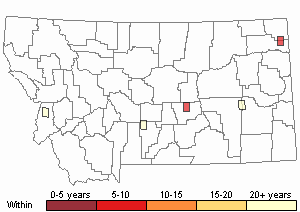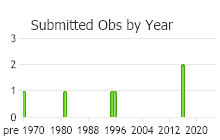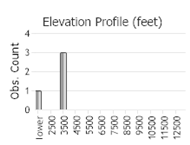View in other NatureServe Network Field Guides
NatureServe
Montana
Utah
Wyoming
Idaho
Wisconsin
British Columbia
South Carolina
Yukon
California
New York
A Dry Rock Moss - Grimmia plagiopodia
Other Names:
A Black Rock Moss
General Description
Plants: Dark green to brown, growing densely in cushions to loose convex tufts with hoary periphery (FNA 2007); central strand typically apparent; rhizoids below (Flowers 1973). Stems 0.3 – 0.5(-1) cm tall (FNA 2007).
Leaves: Erect or flat against the stem when wet and not contorted when dry (Crum 1981), 1 – 1.7 mm in length (not including awn), 0.4 – 0.8 mm in width, oblong-ovate, concave-carinate (FNA 2007), leaves and awns both longer as stem tip is approached (Crum 1981); awn 0.3 – 1 mm (FNA 2007); costa flat to slightly grooved, disappearing at the awn’s base (Crum 1981); margins smooth (Flowers 1973).
Leaf Cells: Basal laminal cells squarish to short-rectangular with straight delicate walls (Crum 1981). Medial laminal cells similarly shaped but are slightly wavy and have somewhat thick walls. Distal laminal cells 1-layered, marginal cells 1-2-layered (FNA 2007).
Diagnostic Characteristics
G. plagiopodia generally inhabits meadow-like sites and at lower elevations compared to G. anodon. G. plagiopodia’s sigmoid seta topped by a peristomatic capsule with perforated full teeth helps in its recognition. G. anodon lacks a peristome and has an annulus. The leaves of G. plagiopoda are 2-stratose and more concave then G. anodon’s mostly 1-stratose, more keeled leaves (FNA 2007).
Range Comments
Greenland; Canada: AB, BC, NT, NU, ON, SK; USA: AK, CA, CO, ID, IL, IA, MN, MT, NE, NV, NM, ND, SD, UT, WI, WY; South America; Eurasia; Pacific Islands (New Zealand); Antarctic. G. plagiopoda is found almost continuously across the northern Great Plains on limestone. It extends into the mountains of the West on limestone and basic sandstone (FNA 2007). In Montana, known from Carter, Cascade, Choteau, Fallon, Garfield, Ravalli, Roosevelt, Rosebud, Sweet Grass, Valley, and Yellowstone Counties (Elliott 2016).
Observations in Montana Natural Heritage Program Database
Number of Observations: 6
(Click on the following maps and charts to see full sized version)
Map Help and Descriptions
Relative Density

Recency



 (Observations spanning multiple months or years are excluded from time charts)
(Observations spanning multiple months or years are excluded from time charts)
Habitat
Sandstone and limestone (Elliott 2016), even concrete sometimes, and silt from glacial lakes. Low to high elevations (160 – 7900 feet) (FNA 2007).
Reproductive Characteristics
Autoicous (Crum 1981). Commonly fertile. Seta S-shaped, 0.2 – 0.3 mm. Capsule usually present (FNA 2007).
Stewardship Responsibility
References
- Literature Cited AboveLegend:
 View Online Publication
View Online Publication Crum, H.A. and L.E. Anderson. 1981. Mosses of Eastern North America. 2 volumes. Columbia University Press, New York. 1328 pp.
Crum, H.A. and L.E. Anderson. 1981. Mosses of Eastern North America. 2 volumes. Columbia University Press, New York. 1328 pp. Elliott, J.C. and A.K. Pipp. 2018. A Checklist of Montana Mosses (1880-2018). Updated 3 January, 2020. Montana Natural Heritage Program, Helena, Montana. 73 pp.
Elliott, J.C. and A.K. Pipp. 2018. A Checklist of Montana Mosses (1880-2018). Updated 3 January, 2020. Montana Natural Heritage Program, Helena, Montana. 73 pp. Flora of North America Editorial Committee, eds. 2007. Flora of North America North of Mexico. Volume 27. Bryophytes: Mosses, Part 1. Oxford University Press, Inc., NY. xxi + 713 pp.
Flora of North America Editorial Committee, eds. 2007. Flora of North America North of Mexico. Volume 27. Bryophytes: Mosses, Part 1. Oxford University Press, Inc., NY. xxi + 713 pp. Flowers, S. 1973. Mosses: Utah and the West. Brigham Young University, Provo, Utah. 567 p.
Flowers, S. 1973. Mosses: Utah and the West. Brigham Young University, Provo, Utah. 567 p.
- Additional ReferencesLegend:
 View Online Publication
View Online Publication
Do you know of a citation we're missing? Elliot, J. C. 1993. Second checklist of Montana mosses. Unpublished report. U.S. Forest Service, Region 1. Missoula, MT. 45 pp.
Elliot, J. C. 1993. Second checklist of Montana mosses. Unpublished report. U.S. Forest Service, Region 1. Missoula, MT. 45 pp. Lawton, E. 1971. Keys for the Identification of the Mosses on the Pacific Northwest. Reprinted from 'Moss Flora of the Pacific Northwest'. Published as Supplement No. 2 of the Journal of the Hattori Botanical Laboratory. Nichinan, Miyazaki, Japan. 66 pp.
Lawton, E. 1971. Keys for the Identification of the Mosses on the Pacific Northwest. Reprinted from 'Moss Flora of the Pacific Northwest'. Published as Supplement No. 2 of the Journal of the Hattori Botanical Laboratory. Nichinan, Miyazaki, Japan. 66 pp. Lawton, E. 1971. Moss Flora of the Pacific Northwest. Hattori Botanical Laboratory. Japan: Yamabuki-cho, Shinjuku-ku, Tokyo. 362 pages plus appendices.
Lawton, E. 1971. Moss Flora of the Pacific Northwest. Hattori Botanical Laboratory. Japan: Yamabuki-cho, Shinjuku-ku, Tokyo. 362 pages plus appendices.
- Web Search Engines for Articles on "A Dry Rock Moss"





